
Homemaking is mainly an American and Canadian term for the management of a home, otherwise known as housework, housekeeping, housewifery or household management. It is the act of overseeing the organizational, day-to-day operations of a house or estate, and the managing of other domestic concerns. A person in charge of the homemaking, who is not employed outside the home, in the US and Canada, is called a homemaker, a term for a housewife or a househusband. Historically the role of homemaker was often assumed by women. The term "homemaker", however, may also refer to a social worker who manages a household during the incapacity of the housewife or househusband. Home health workers assume the role of homemakers when caring for elderly individuals. This includes preparing meals, giving baths, and any duties the person in need cannot perform for themselves.
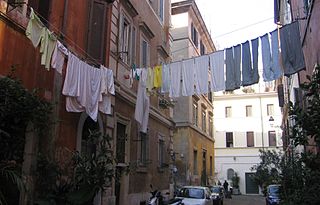
Laundry refers to the washing of clothing and other textiles, and, more broadly, their drying and ironing as well. Laundry has been part of history since humans began to wear clothes, so the methods by which different cultures have dealt with this universal human need are of interest to several branches of scholarship. Laundry work has traditionally been highly gendered, with the responsibility in most cultures falling to women. The Industrial Revolution gradually led to mechanized solutions to laundry work, notably the washing machine and later the tumble dryer. Laundry, like cooking and child care, is still done both at home and by commercial establishments outside the home.
A washing machine is a home appliance used to wash laundry. The term is mostly applied to machines that use water as opposed to dry cleaning or ultrasonic cleaners. The user adds laundry detergent, which is sold in liquid, powder, or dehydrated sheet form, to the wash water.
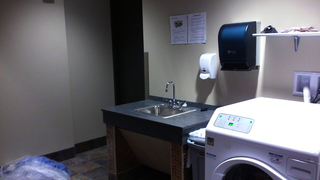
A laundry room is a room where clothes are washed and dried. In a modern home, a laundry room would be equipped with an automatic washing machine and clothes dryer, and often a large basin, called a laundry tub, for hand-washing delicate articles of clothing such as sweaters, and an ironing board. A typical laundry room is located in the basement of older homes, but in many modern homes, the laundry room might be found on the main floor near the kitchen or upstairs near the bedrooms.

A clothes line, also spelt clothesline and also known as a washing line, is a device for hanging clothes on for the purpose of drying them. It is any type of rope, cord, or twine that has been stretched between two points, outside or indoors, above the level of the ground. Clothing that has recently been washed is hung along the line to dry, using clothes pegs or clothespins. Washing lines are attached either from a post or a wall, and are frequently located in back gardens, or on balconies. Longer washing lines often have props holding up sections in the middle due to the weight of the usually wet clothing.

Persil is a German brand of laundry detergent manufactured and marketed by Henkel around the world except in the United Kingdom, Ireland, France, Latin America, China, Australia and New Zealand, where it is manufactured and marketed by Unilever. Persil was introduced in 1907 by Henkel. It was the first commercially available laundry detergent that combined bleach with the detergent. The name was derived from two of its original ingredients, sodium perborate and sodium silicate.

A posser, ponch, washing dolly or a poss stick was historically a tool used for possing laundry by pumping the posser up and down on the laundry in the dolly tub or directly in the copper, or mixing laundry while hand washing it. Possers come in various forms; there is usually a vertical pole with a handle bar at the top but the base can be conical or domed. It has a double rim with a row of holes around the edge of the outer one. A similar tool with three legs was called a variety of names including posstick, peggy-legs, dolly-legs, and dolly-peg. Sometimes they took the form of a flat disk. The naming of each of these items was regionally specific and the specific meaning of word changed over time.

A laundry ball or washing ball is a product made of solid, insoluble material promoted as a substitute for laundry detergent. Producers of laundry balls often make pseudoscientific claims about their mechanisms of action and exaggerate the extent of their benefits.

A combo washer dryer is a combination in a single cabinet of a washing machine and a clothes dryer. It should not be confused with a "stackable" combination of a separate washing machine and a separate clothes dryer.

Washing out the mouth with soap is a traditional form of physical punishment that consists of placing soap, or a similar cleaning agent, inside a person's mouth so that the person will taste it, inducing what most people consider an unpleasant experience. This form of punishment was especially common in the United States and United Kingdom from the late 19th century until the mid-20th century.

A self-service laundry, coin laundry, or coin wash, is a facility where clothes are washed and dried without much personalized professional help. They are known in the United Kingdom as launderettes or laundrettes, and in the United States, Canada, Australia and New Zealand as laundromats. In Texas and other parts of the south central United States, the term washateria is still used by some older speakers.

A lavoir (wash-house) is a public place set aside for the washing of clothes. Communal washing places were common in Europe until industrial washing was introduced, and this process in turn was replaced by domestic washing machines and by launderettes. The English word is borrowed from the French language, which also uses the expression bassin public, "public basin".
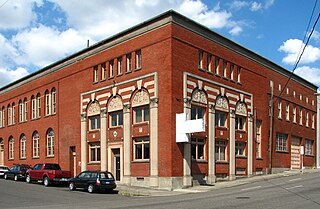
The Yale Union Laundry Building, also known as the Yale Laundry Building, the City Linen Supply Co. Building, Perfect Fit Manufacturing and simply Yale Union (YU), in southeast Portland, Oregon, is a two-story commercial structure listed on the National Register of Historic Places. Built largely of brick in 1908, and embellished with Italian Revival and Egyptian Revival decorations, it was added to the register in 2007. Two-story additions in 1927 and 1929 changed the original building into an L-shaped structure that shares a party wall with a building to the east.
Ellen F. Eglin was an African-American inventor who was an African-American inventor who invented a type of clothes wringer for washing machines.

A washboard is a tool designed for hand washing clothing. With mechanized cleaning of clothing becoming more common by the end of the 20th century, the washboard has become better known for its secondary use as a musical instrument.

A stone slab is a big stone, flat and relatively thin, often of rectangular or almost rectangular form. They are generally used for paving floors, for covering walls or as headstones.
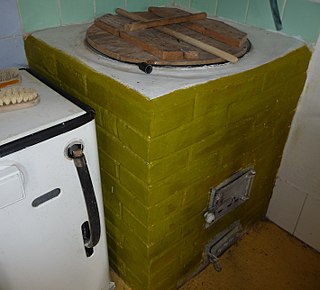
A wash copper, copper boiler or simply copper is a wash house boiler, generally made of galvanised iron, though the best sorts are made of copper. In the inter-war years they came in two types. The first is built into a brickwork furnace and was found in older houses. The second was the free-standing or portable type, it had an enamelled metal exterior that supported the inner can or copper. The bottom part was adapted to hold a gas burner, a high pressure oil or an ordinary wood or coal fire. Superior models could have a drawing-off tap, and a steam-escape pipe that lead into the flue.

Dadeumi (Korean: 다듬이) or dadeumijil (다듬이질) or kinuta (砧) is a Korean traditional ironing method where two women knelt on the floor, facing each other across a smoothing stone, beating out a rhythm on the cloth to press out its wrinkles and soften it.
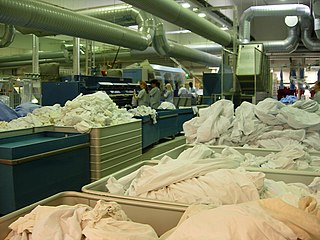
A laundry-folding machine or laundry-folding robot is a machine or domestic robot which folds apparel such that they can be stored compactly and orderly

















